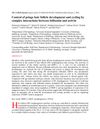A 'Hot' New Twist to Hair Biology: Involvement of Vanilloid Receptor-1 Signaling in Human Hair Growth Control
September 2004
in “
Experimental Dermatology
”
vanilloid receptor-1 VR1 capsaicin TGFβ2 IL‐1β HGF IGF‐1 SCF anagen phase catagen phase outer root sheath keratinocytes HaCaT keratinocytes apoptosis intracellular calcium vanilloid receptor transforming growth factor beta 2 interleukin 1 beta hepatocyte growth factor insulin-like growth factor 1 stem cell factor
TLDR VR1 signaling can inhibit hair growth by affecting cell processes and increasing hair growth inhibitors.
The study investigated the role of vanilloid receptor-1 (VR1) in human hair growth control, revealing that VR1 was present in specific epithelial compartments of hair follicles during anagen and catagen phases but absent in dermal papilla fibroblasts and hair follicle melanocytes. Activation of VR1 by capsaicin in organ culture led to a dose-dependent inhibition of hair shaft elongation, reduced cell proliferation, increased apoptosis, and induced catagen transformation, likely due to the upregulation of TGFβ2, a hair growth inhibitor. Additionally, VR1 stimulation in cultured outer root sheath keratinocytes and HaCaT keratinocytes inhibited proliferation, induced apoptosis, and increased intracellular calcium levels. It also upregulated hair growth inhibitors (IL‐1β and TGFβ2) and downregulated growth stimulators (HGF, IGF‐1, and SCF), without affecting key differentiation markers. The findings suggested that VR1 played a significant role in hair growth control, extending its known functions beyond sensory neuron-related nociception.






